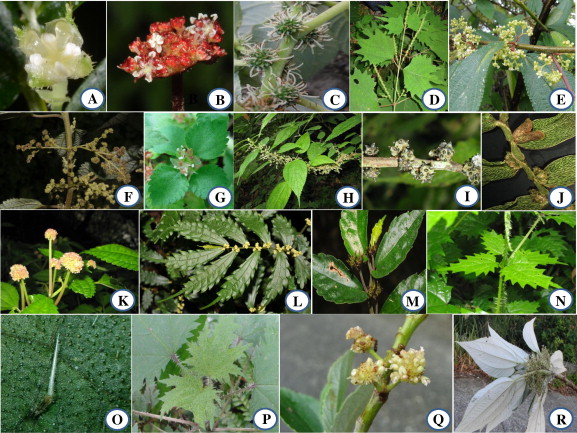昆植所构建完成荨麻科分子系统发育框架
来源:《Molecular Phylogenetics and Evolution》
作者:李德铢等
时间:2014-01-06

荨麻是被子植物中一个较大的科,广泛分布于两半球的热带地区。荨麻科的很多种类有重要的经济价值、药用价值和生态价值,但由于很多重要分类性状极其微小,不易观察。迄今为止,其科下属间的系统关系仍然存有争议。
中国科学院昆明植物研究所博士研究生吴增源在研究员李德铢的指导下,与英国皇家植物园——邱园和爱丁堡皇家植物园合作,使用最大似然(ML)、最大简约法(MP)和贝叶斯推断(BI)分析两个核DNA位点(IT和18S),四个叶绿体区域(matK基因, rbcL,rpll4–RPS8–INFA–rpl36,–trnL trnL-TRNF)和一个线粒体基因(rbcL基因),呈现了荨麻科密集样本的分子系统发育结构。
169份样本来自47属(公认的54属)122种。主要结果如下:(1)荨麻科是单系发育类群, Cecropiaceae(锥头麻科) 属于荨麻科的一部分;(2)Cecropiaceae在荨麻科内有两个谱系;(3)荨麻科可分为四个分支;(4)以前建立的族或亚科得到较好的遗传分子支持,并有一些补充和修改;(5)分子分析结果支持多属单系的结论,苎麻属、赤车属、雾水葛属、Urera 均被证明为多系类群,冷水花属和荨麻属分别有一个小属Sarcopilea、Hesperocnide 包含其中;(6)科下属间关系受分子分析结果支持而得以明确。
这些结果澄清了一些过去高估的形态特征及以前分类的误判,并为进一步的生物地理学研究、形态性状演化和类属的界定等打下了坚实的基础。该研究成果日前发表在专业期刊《分子系统发育及进化》上。(编译:中国科学院成都生物研究所 王芋华,王海燕)
Molecular phylogeny of the nettle family (Urticaceae) inferred from
multiple loci of three genomes and extensive generic sampling
Abstract Urticaceae is one of the larger Angiosperm families, but relationships within it remain poorly known. This study presents the first densely sampled molecular phylogeny of Urticaceae, using maximum likelihood (ML), maximum parsimony (MP) and Bayesian inference (BI) to analyze the DNA sequence data from two nuclear (ITS and 18S), four chloroplast (matK, rbcL, rpll4–rps8–infA–rpl36, trnL–trnF) and one mitochondrial (matR) loci. We sampled 169 accessions representing 122 species, representing 47 of the 54 recognized genera within Urticaceae, including four of the six sometimes separated as Cecropiaceae. Major results included: (1) Urticaceae including Cecropiaceae was monophyletic; (2) Cecropiaceae was biphyletic, with both lineages nested within Urticaceae; (3) Urticaceae can be divided into four well-supported clades; (4) previously erected tribes or subfamilies were broadly supported, with some additions and alterations; (5) the monophyly of many genera was supported, whereas Boehmeria, Pellionia, Pouzolzia and Urera were clearly polyphyletic, while Urtica and Pilea each had a small genus nested within them; (6) relationships between genera were clarified, mostly with substantial support. These results clarify that some morphological characters have been overstated and others understated in previous classifications of the family, and provide a strong foundation for future studies on biogeography, character evolution, and circumscription of difficult genera.
Highlights
•Urticaceae including Cecropiaceae was monophyletic; and Cecropiaceae was biphyletic, nested within Urticaceae.
•Urticaceae comprised four well-supported clades.
•Previously erected tribes or subfamilies were broadly supported, with some additions and alterations.
•The monophyly of many genera was supported, whereas some genera were clearly polyphyletic.
•Relationships between genera were clarified, mostly with substantial support.
原文链接:http://www.sciencedirect.com/science/article/pii/S1055790313002625




